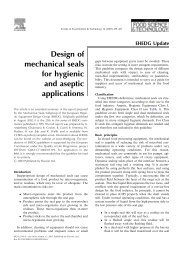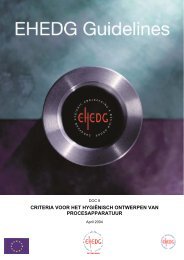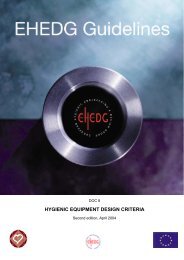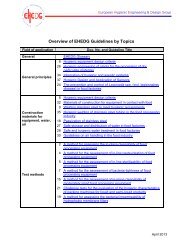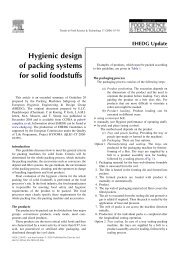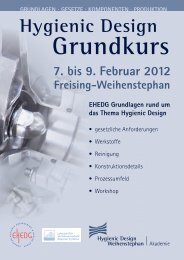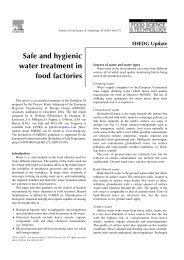Yearbook 2013/2014 - ehedg
Yearbook 2013/2014 - ehedg
Yearbook 2013/2014 - ehedg
Create successful ePaper yourself
Turn your PDF publications into a flip-book with our unique Google optimized e-Paper software.
European Hygienic Engineering & Design Group<br />
The future of food grade lubrication<br />
Food safety is and will remain the most important issue in the food production industry. Issues<br />
such as 100% machine availability and cost-cutting and efficiency programs also are important<br />
to a processing plant’s performance. As food processors aim to meet the objectives of both<br />
food protection and production efficiencies in a slow economy, it is important to consider how<br />
food grade lubricants can play a positive role in many operations.<br />
Taco Mets, Van Meeuwen Groep B.V., NL-1382 LV Weesp, e-mail: tm@vanmeeuwen.nl<br />
Fortunately, the going concern of the food industry is not at<br />
stake: Everybody will continue to consume food. Despite<br />
the economic crisis resulting in a global manufacturing<br />
slowdown, the food industry continues to run strong.<br />
However, margins are always under pressure and many<br />
people do not realise what is essential to keep production<br />
plants operating efficiently. Today, not only are food safety<br />
rules and regulations becoming increasingly strict but<br />
company budgets are getting tighter and more limited for<br />
technical departments driven by mandatory cost-efficiency<br />
programs. These realities make it more important than ever<br />
for food manufacturing operations to find ways to achieve<br />
both objectives simultaneously.<br />
Differences in lubricants for food processing<br />
applications<br />
Creating a mindset for preventive maintenance is the<br />
most important factor in establishing an environment in<br />
which significant advantages can be achieved with quality<br />
lubricants. Food manufacturers should make sure to use H1<br />
registered lubricants, which are allowed for incidental food<br />
contact (Figure 2). Many experts in the lubrication sector<br />
believe products that are H2 registered (products for the<br />
food industry that are absolutely not allowed to come into<br />
contact with food) will disappear from the market. Either the<br />
processor uses a food grade lubricant, or not, that is the key<br />
choice. Today’s technology makes it possible to formulate a<br />
H1 registered lubricant for (almost) every application.<br />
Figure 1. Lubrication maintenance is key to sustainable and<br />
hygienic performance of production lines.<br />
Food processors can maximise their current machinery<br />
performance by focusing on maintenance of all equipment<br />
and components along the production line. There is little<br />
to be gained by a costly revision of a whole production line<br />
and not optimising every aspect of maintenance of this line<br />
to guarantee a long sustainable performance after revision<br />
(Figure 1). Lubrication is key in this process. A focus on<br />
the lubrication aspect of maintenance means investing in<br />
quality lubricants, combined with performing a structural<br />
trend analysis. Together, these will result in both hygienic<br />
production and significant cost savings.<br />
Figure 2. Food manufacturers should select the right type of<br />
lubricant for the right application.<br />
Processors may also have heard about 3H lubricants.<br />
These 3H registered lubricants (to be differentiated from H3<br />
lubricants that represents soluble and edible oils that prevent<br />
rust) are allowed to come in direct food contact. There are<br />
certain applications and situations in which contact with<br />
the food product is inevitable, and in these situations, a 3H<br />
registered lubricant is a good choice.<br />
It is important to note that sometimes the status of NSF<br />
International (US) and/or InS Services (UK) non-food<br />
compound certification is unclear. Both registration institutes<br />
use the similar U.S. Department of Agriculture/U.S. Food<br />
and Drug Administration (USDA/FDA) guidelines. Therefore,<br />
a lubricant needs to have an H1 or other registration<br />
regardless of whether certification is from NSF or InS.



